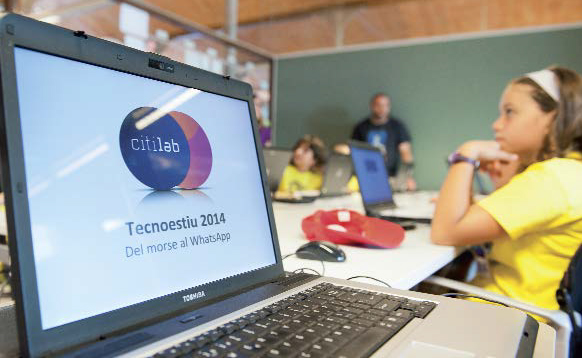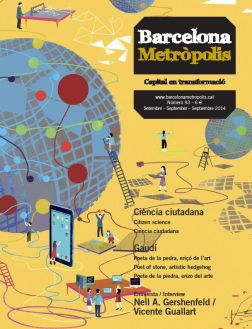The Cornellà Citilab opened its doors in 2007 thanks to a grant from the ERDF that transformed the old Can Suris factory into a citizen lab.

© Albert Armengol
Tecnostiu, activities at the Citilab in Cornellà during which children and young people come into close contact with new technologies and TV production.
The hypotheses underpinning the opening of Citilab in 2007 have been confirmed. Last year, the European Commission considered that Citilab was a good practice in technological and social innovation, and included it as a success story in the European Guide to Social Innovation. Thanks to programmes such as Horizon 2020 and the European Regional Development Funds, Europe has begun to support social innovation, bottom-up processes and the quadruple helix: a new model that recognises the role of social partners in this work. The Internet, as a network designed according to the end-to-end principle – where intelligence is located at the ends and not only at the core – was already facilitating open innovation processes. But it lacked a social institution that could embody these principles and transfer them to the field of innovation. The forerunners were the citizens’ networks. It was also essential to democratise innovation through digital tools and using the possibilities for collaboration offered by the Internet.
To achieve this, the Citilab project set itself three goals. Firstly, the centre had to be a model or a benchmark for a new social Internet that could be used to develop training, research and entrepreneurship. Secondly, it had to promote digital literacy among citizens to unlock research for everyone. Finally, the Citilab had to be a living lab – a term coined by Professor William Mitchell of the MIT Media Lab in 2006 – that is, a living laboratory for the testing, validation, prototyping and fine-tuning of complex solutions in real and constantly evolving environments.
On opening its doors, Citilab asked all-comers one question: “So what do you want to do?” People reacted with some surprise, as it is not an easy question, and one they were not expecting. The users were expecting to be given a clear offer. Many wanted to learn, so as not to get left behind. But learn what? The Citilab was not a telecentre or an IT school. Its goal was to help people with a desire to innovate to achieve this aim, and to do so by networking with companies, the government and universities.
In its early years, Citilab targeted different groups, such as children, young people, adults, the elderly, women, teachers, professionals, musicians, athletes, etc., to link their desire to learn with an innovative vocation. This spawned the idea of “learning to innovate” as the signature characteristic of the Citilab model, learning by co-designing and co-developing innovation projects, where they were the key players.
Over the years, Citilab has refined its own way1 of taking innovation to everyone. It includes its own user-centred design and engineering methods, plus others that come from applied social sciences. We rely basically on computational thinking and the design world. We use literacy in new media, user-generated content and project-by-project learning that all allows us to unite the worlds of learning and innovation.
Citilab began to weave a local network, at the same time as a European and global one. It is a founding member of ENoLL, the European network of living labs, with which we share the basics of user-centred innovation, open innovation, co-creation and the same living lab model. This two-pronged local and European alliance has allowed us to weather the economic crisis. The support of Cornellà City Council and our European projection have been key to our survival over the last few years.
Citizen labs work primarily thanks to the support of their local community. This is a lesson we never forget. At this point we need to recover the initial thrust and open up even further. To this end, we apply everything we have learned in order to look for new employment opportunities; to invent new jobs with young people with drive instead of just looking for one, or helping the unemployed to connect with the job market through the active use of social networks.
We are currently continuing with the projects to help adults learn to innovate, we are still teaching programming to children, and we are supporting innovative instructors who teach programming, because we believe in giving citizens tools that will help them to develop smarter cities. An example of this is our commitment to the S4A app which combines, firstly, Scratch programming language, with which students can create their own applications, and secondly, an Arduino board, which contains a microcontroller with which you can interact with the physical world from your computer. We feel it is very important that citizens make use of digital tools to produce content, but even more importantly they need to be able to create or modify these tools before they can innovate. To do this they need to master ICT and think computationally. Programming is the new language to learn.
The cities of the future need governments to break away from departmental logic and connect with innovation ecosystems in their regions. Projects like iCity work in this line and have made it possible to propose a methodological approach to promoting new relationships between public and private stakeholders for the co-creation of services based on the complex and necessary processes of opening up public resources, data and information systems. To begin with, we need to identify the barriers and motivations for collaboration and then weave relationships, proposing shared spaces and challenges so we can do things together, or, to put it another way, co-design, co-create and co-produce solutions to shared challenges.
If cities want to encourage citizen engagement or promote citizen involvement, we need a relationship framework with a set of clear and fair rules, as well as short- and long-term objectives. Fortunately, Citilab is not alone in this process. It coexists with organisations based on networking and digital culture, such as hack labs, media labs and fab labs, and a proliferation of other labs and projects that will transform organisations in the areas of business, culture, research and public administration born of the industrial model. With all of them, Citilab wants to foster citizens who, besides being customers, users or sensors that produce data, will participate fully in the innovation taking place in their city.
References
1 – Astrid Lubsen, Citilab little handbook on people-centered design. Citilab-Cornellà, 2010.



